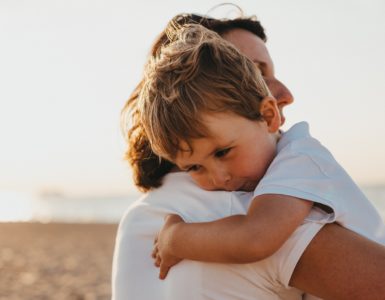If you are new to the world of adoption, you may not be familiar with open adoption or how common it has become. Years ago, it was normal and expected for adoptions to be completely closed. However, with sealed records and no identifying information available, many families have been left searching for puzzle pieces they may never find. There was also a sense of secrecy with these adoptions, which gives the idea that there is something to hide or be ashamed of. This often had negative effects on all members of the adoption triad. While closed and confidential adoptions do still occur, they are no longer the norm. So…what is open adoption? To put it simply, this term means that the biological and adoptive families may share information and are able to have some form of communication between them.
With the prevalence of open adoption in recent decades, the answers are made available before the questions are even asked. Open adoption can be beneficial for every member of the adoption triad. Whether you are considering making an adoption plan for your child or becoming a parent through the process of adoption, openness is definitely something to take into consideration. It can be helpful to break it down into smaller pieces to better understand and answer the question of, what is open adoption?
The Benefits
At first, the idea of open adoption can be a bit intimidating. When adopting a child, you may be nervous to meet the birth family—let alone involve them in your lives. When placing a child for adoption, you may wonder if it will be painful to receive contact from the adoptive family. While there may be some ups and downs along the way, there are many benefits to maintaining a level of openness.
- Benefits for Birth Parents
- Most birth parents come to an adoption decision after a great deal of thought and with a tremendous amount of love. Because they have built a bond with their child (either during pregnancy or if the child is older—over the course of their life thus far), the decision to place a child with another family can be incredibly emotional and difficult to face. Even when the biological parents feel that adoption is the best decision for their child, they typically have numerous questions racing through their minds: “Who will be raising my child? Are they good people? Will my baby ever know about me? How will I know if my birth son/daughter is happy and healthy?”
- When making an open adoption plan, these questions become easier to answer. In most cases, birth parents are able to browse through listings of prospective adoptive parents. When looking through these profiles, a birth parent can get an idea of the type of family they may be placing their child with. They may learn why a family is choosing to adopt, what their hobbies and interests are, and get a general sense of their personalities. Perhaps they would like their child to be raised with certain religious beliefs. Maybe they are hopeful that their child will have siblings or pets (or neither). They may prefer a family with a great sense of humor or a love for music. Making an informed decision on the home their child will be raised in can help to ease the anxiety that comes along with an adoption placement. An expectant parent may have a greater sense of control and a feeling of relief knowing that they have a choice.
- Another benefit for birth parents considering open adoption is continued contact with the adoptive family. Whether the adoption is semi-open or wide open, there will be some form of communication. Birth parents may receive updates on their child’s growth and milestones. This may be done through letters, photos, emails, and social media. In many cases, families opt to have visits as well. Knowing that the child is thriving in their new home can help to reassure a birth parent that they have made a good decision for their son or daughter. With an open line of communication, there is a chance that both families will be involved in the life of the child. If adoptive parents are open about a child’s adoption story from the beginning, that child will know that they came from one loving family into another. In addition to the birth parents having a relationship with the adoptive family, the opportunity for biological grandparents, aunts, uncles, and siblings to have contact is a possibility as well.
- Birth parents often go through a grieving process when placing a child for adoption. With an open adoption, the mourning may often be significantly eased and the healing time may be shorter. Because any sense of guilt or shame is minimized, a birth mother doesn’t have to live in secrecy with her choice (unless she prefers to do so). In recent years, birth parents have been celebrated and loved rather than being hushed and hidden.
- Benefits for Adoptive Parents
- When parents are considering growing their family through adoption, they may be a bit skeptical about openness. It’s quite a normal desire to be like typical biological families—just one set of parents raising their children. “Why is there a need to have contact with the birth family when we will be the only parents our child needs?” There is no need to fret. Open adoption does not mean that your child has two sets of parents raising the child. The adoptive parents are still the legal parents. They will have all of the legal rights and responsibilities of raising the child. Maintaining a level of openness with the birth family doesn’t make you any less of a parent. In fact, it can help you to meet your child’s needs even better.
- Because birth parents may be more likely to create an adoption plan when there is a level of openness, a hopeful adoptive family’s wait time might be decreased. When contact and ongoing communication are established between adoptive and birth families, it is easier to understand the motives and the emotions of each party. This can decrease any lingering fear of what the birth parents’ intentions may be. Adoptive parents are also able to easily access any information they may need. If any questions regarding medical history arise, they can be easily answered. It can also be flattering and encouraging to know that a couple or individual has been handpicked to become parents to a specific child. Plus, adoptive parents may be able to answer any questions their children may have with much more knowledge and confidence.
- Benefits for Adoptees
- An open adoption eliminates the need for an adoptee to search for the biological family. This can save time, effort, and heartache for everyone. A child can easily learn more about their roots and their identity and they do not have to face the fear of rejection or uncertainty that sometimes comes with searching for their birth family. Questions like, “Who am I and where did I come from?” and “Why was I placed for adoption?” are more easily answered. The sense of abandonment that sometimes comes with having been adopted could be decreased when an adoptee knows the whats and whys of their adoption story.
- When medical concerns arise during childhood OR adulthood, medical history is much easier to obtain. If a child has a desire to spend time with their birth family, they are often able to do so. While a child doesn’t see their birth parents as mom or dad, they may consider them part of the extended family. This is a positive thing because it means that a child has two families to love and support them.
Types of Open Adoption
Although all forms of open adoption do have similarities, there can be many differences as well. Some adoptions are wide open. In these adoptions, the biological parents are treated as extended family members. They may be in contact with the adoptive family on a daily, weekly, or monthly basis. They may share phone calls, connect on social media, and even have frequent visits. Birth parents may be invited on family outings or to birthday parties and holiday events.
Other adoptions are semi-open. While there is some identifying information shared, there are also more boundaries. For example, photos and letters may be exchanged through the agency—meaning that neither party has the address of the other. Visits may occur once a year or not at all.
Many adoptions fall somewhere between the two, or they can be completely different. The level of openness and communication may vary over time as the needs of both families change. There is not a specific set of rules that governs the degree of openness that will occur. It is ultimately up to the family to decide.
Getting Started
Now that you know the basic answer to the question, “What is open adoption?” as well as some of its benefits— you may wonder how to begin the process. If you are a biological parent considering making an adoption plan for your child, make sure that you have explored all of your options. Explore the pros and cons that may come along with parenting, kinship care (placing your child with a family member), and placing your child in a closed, semi-open, or fully open adoption. As an adoptive parent, consider the level of openness you feel most comfortable with as well.
Do your research in choosing an attorney or an adoption agency that will best facilitate your adoption and help you as you navigate the process. Consider things such as pre- and post-adoption education, training, and/or counseling. Will your adoption agency or professional be capable of mediating your adoption or providing you with support when needed? Do they have positive reviews? Ask any questions that may arise, and don’t feel that any of them are unimportant or silly. If possible, speak with others who have been in your situation and learn what you can from their experiences. They may be able to offer great advice. It can also be helpful to explore the adoption laws in your specific state so that you have a clear understanding of your rights. There may be regulations on specifics such as:
- Advertising to find birth parents or adoptive parent
- Who can legally help you to facilitate your adoption
- Adoption consent and finalization
- Requirements for adopting
- Background checks
- Expenses and fees that may be paid by adoptive parents
- Post-adoption contracts and agreement
It is important to note that once an adoption is finalized, the biological parents’ rights will be legally terminated, and the adoptive parents will retain permanent legal rights and guardianship. It’s not just the birth mother who needs to sign the paperwork. Most states require the consent of the biological father as well (if he is able to be found and contacted). While some birth fathers have no desire to build a relationship with the adoptive family, many others appreciate the opportunity to do so. They may also care very much about their child and want to share information and maintain some level of contact. With an open adoption, terminating the rights does not mean terminating the relationship. It will be up to the families to decide what an open adoption means to them. This should ideally be done prior to the adoption placement.
Even when an adoption plan has been made, it does not become legal until after the baby is born. Birth parents should not make a decision based upon pressure from any other party. Before signing any legal paperwork, the birth parents should feel certain that adoption is their decision and that they are not being coerced in any way. An adoption placement is a major, life-altering decision and should be considered very carefully. While many states do offer a short time period to revoke consent, it’s best for everyone involved if the party is confident in their decision before signing any paperwork.
Meeting the Other Family
After a hopeful adoptive family has undergone any necessary training and a home study, they will often provide a profile to the adoption agency. This profile will be made available to prospective birth parents who are choosing a family for their unborn child. Birth parents will often undergo counseling, ask any questions they may have, and will choose an adoptive family that they feel best meets their child’s needs as well as cooperating with their own wishes.
Once a birth parent has decided upon a couple, a meeting will often be set up. This meeting will ideally occur months before a child is ready to be placed for adoption so that there is time to get to know the other family. The first meeting may be awkward. It may be emotional. It may feel like destiny that the families have found each other. Regardless of how this first meeting goes, it is important to build a rapport and have an open line of communication between families. This may be the only meeting before the adoption occurs, or there may be many more along the way. If the first meeting goes well and the birth parents decide that they would like to proceed in choosing that specific family, they may not need to meet with any other potential families. If the meeting isn’t what they expected, they may potentially meet with others as well.
Honest Communication, Ground Rules, & Boundaries
When meeting the adoptive parents or the biological family, it is important to be open and honest with your wishes concerning the future. While it can be tempting to say whatever the other party wants to hear in order to ensure the placement happens—it is much more beneficial to be upfront with what you can realistically expect from each other. Speak candidly about why you are choosing to adopt or choosing to place your child for adoption. Discuss the level of openness that you feel would be most beneficial for your family. Don’t make promises that you know you can’t keep. If there is any aspect of openness that you don’t feel comfortable with, be upfront about it. Let the other party know exactly what your hopes are, where the boundaries will be set, and if contact will remain consistent throughout the years to come. Of course, life sometimes happens and families do change and adjust as time goes on. As long as you respect the wishes of the other family, they will often do the same. Being honest from the very beginning can make the entire process go much more smoothly. It is incredibly helpful when both families have a realistic basis for what to expect and can set both goals and boundaries.
As time goes by, do your best to remain in contact in a way that best suits your lifestyle and your needs. Even when life gets busy, a quick card, a few photos, or a phone call can go a long way. If visits are part of your agreement, make time to set them up in a fun and comfortable environment. If complications arise, the agency can help to mediate the relationship and the contact. However, if everything goes smoothly, delight in knowing that two families have come together in unconditional love for a child. Both families have much to offer to the child and to each other.
What Is Open Adoption? A Loving Option!
When entered into with love, adoption can be advantageous to everyone involved. Birth parents can rest assured that their child will be well provided for as they watch them grow and thrive in a stable, nurturing home. Adoptive parents can bring a child into their homes and their hearts, confident that their child may not have to face the doubts and uncertainty that typically come with closed adoptions. Children who have been adopted can grow up surrounded by love and support from all sides. Keep an open mind and consider open adoption. It’s a wonderful way to build a forever family.
Are you ready to pursue adoption? Visit Adoption.org or call 1-800-ADOPT-98 to connect with compassionate, nonjudgmental adoption specialists who can help you get started on the journey of a lifetime.




